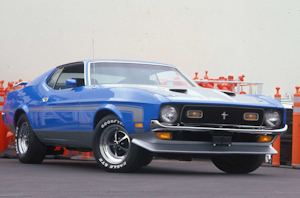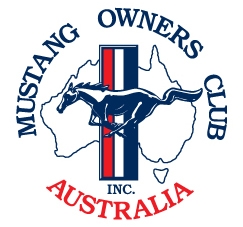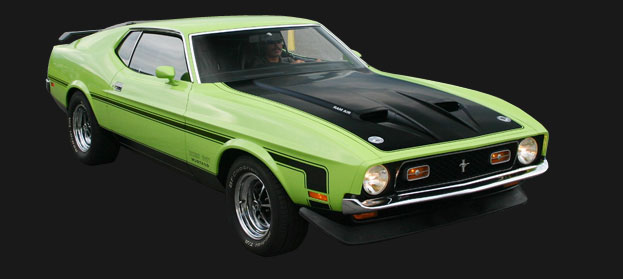BOSS 351 Mustang
Based on the redesigned Mustang SportsRoof, the new Boss was built to qualify a Trans-Am counterpart, a purpose rendered moot by Ford’s late-1970 retirement from most forms of organized racing.
The upside was that the Boss 351 was probably the only 1971 performance car with a genuine competition-grade engine.
Unfortunately, it had to saddle up the biggest Mustang ever. Wheelbase for the 1971 Ford Mustang Boss 351 was up one inch, and the car gained 2.1 inches in overall length, 2.8 inches in width, and put on about 100 pounds. Its styling was influenced by the last of the Shelby models, which didn’t survive into ’71. That left the Mach 1 and Boss 351 as Mustang’s similarly styled performance flag bearers.
Mach 1’s top engine was the 429-cid Super Cobra Jet Ram Air. Its credentials were strong — 11.3:1 compression, 375 bhp, 450 lb-ft of torque — but its low-14 second ETs were slower than those of the Boss 351. The Boss had on its side less weight and exclusive use of a thoroughbred 351-cid V-8 that Car and Driver said made the “Z/28 look like a gas mileage motor.”
Its rods were shotpeened and Magnafluxed and its heads, drawn from the Boss 302, had staggered valves and huge ports. It had a radical, solid-lifter cam, 11.0:1 compression, a 750-cfm four-barrel, and an honest 330 bhp. Ram-air induction, a Hurst-shifted four-speed, and a 3.91:1 Traction-Lok diff were standard.
 The engine, remarkably tame on the street and a dervish on the track, teamed with a “competition” suspension that used F60Xl5 tires. Ultimate cornering power was high, but the car was ponderous and nowhere near as balanced as a Firebird Trans Am. Moreover, the cave-like cabin was frustratingly difficult to see out of, the ride was harsh, and the gauges and controls were poorly designed.
The engine, remarkably tame on the street and a dervish on the track, teamed with a “competition” suspension that used F60Xl5 tires. Ultimate cornering power was high, but the car was ponderous and nowhere near as balanced as a Firebird Trans Am. Moreover, the cave-like cabin was frustratingly difficult to see out of, the ride was harsh, and the gauges and controls were poorly designed.
Mustang had gone from quarter horse to Clydesdale and its best version, Boss 351, lasted just one season. It was a fitting finish to Total Performance.
The 335 series, although sharing the same bore spacing and cylinder head bolt pattern, was very different internally from the somewhat similar-looking Windsor series. The 335 Cleveland used smaller 14 mm spark plugs in one of two different cylinder heads, both with 2 valves per cylinder. The ‘4V’ heads had massive ports and valves compared to the ‘2V’ Both had the valves canted to the sides in a “poly-angle”. The ‘2V’ head had a open, almost hemispherical shaped combustion chamber while the ‘4V’ sported a Quench type combustion chamber. The Cleveland has a very square type rocker cover while the Windsor has a more rounded end cover. All 335 covers are secured with 8 bolts, as opposed to 6 on the Windsor.
A differentiation between the Windsor and Cleveland series are the location of the radiator hose — the Windsor routed coolant through the intake manifold, with the hose protruding horizontally, while the Cleveland had a dry manifold with the radiator hose connecting vertically to the cylinder block above the cam timing chain cover.
Inside the block, large main bearing caps are specified for durability, allowing 4-bolt mains on some engines. The 335 oiling system has been widely criticized because of its ‘non main priority’ schematic; however, for all but the highest level of performance applications, it has not proven any less reliable than the Windsor line.
 The 351 Cleveland was introduced in 1969 as Ford’s new performance car engine and was built through the end of the 1974 model year. It incorporated elements learned on the 385 big-block series and the Boss 302, particularly the poly-angle combustion chambers with canted valves and the thin-wall casting technology.
The 351 Cleveland was introduced in 1969 as Ford’s new performance car engine and was built through the end of the 1974 model year. It incorporated elements learned on the 385 big-block series and the Boss 302, particularly the poly-angle combustion chambers with canted valves and the thin-wall casting technology.
Both a 4V (4-barrel carburetor) performance version and a 2V (2-barrel carburetor) basic version were built, both with 2 valves per cylinder. The latter had a different cylinder head with smaller valves, smaller ports, and open combustion chambers to suit its intended applications.
Only the Q-code 351 “Cobra Jet” (1971–1974), R-code “Boss” 351 (1971), and R-code 351 “HO” (1972) versions have 4-bolt mains although all 335 series engines (351C/351M/400) have provision for them. The main difference between 351C/351M/400 engines is connecting rod length and main bearing size. The 351M/400 engines have the largest bearing size and the tallest deck height while sharing the 429/460 bell housing pattern. The 351C engine has a medium main bearing size (2.75″) and shorter connecting rods (5.78″) than the 351W (5.94″) and the 351M/400 (6.58″) while retaining the SBF (289-302w) engine mount locations and bell housing pattern. The 400 engine has the longest stroke (4.00″) of any SBF or 335 series engine.
All of the 351C and 351M/400 engines differ from the 302/351W by having an integrated timing cover casting in the front of the block to which the radiator hose connects.
H-code
1973 H-code 2V 351 ClevelandThe majority of 351 Cleveland engines are H-code 2V (2-venturi carburetor) versions with low compression. They were produced from 1970 through 1974 and were used on a variety of Ford models, from ponycar to fullsize.
M-code
The 351C 4V engines produced in 1970 and 1971 used this code. Engines varied in compression ratio; 1970 engines were 11.0:1 compression and produced 300 bhp (224 kW; 304 PS) at 5400 rpm, while 1971 versions had a slightly lower compression ratio of 10.7:1, and a reduced power output of 285 bhp (213 kW; 289 PS) at 5400 rpm. Ford owner’s manuals for these engines recommended high octane gasoline (100+ octane in 1970) which was at the high end of the leaded gasoline available at the time. However, with the mid 1970’s introduction of unleaded gasoline and lower octane ratings, and subsequent disappearance of the super high octane leaded fuels required to power these high compression engines, motorists were either unaware of potential damage or simply unable to find this kind of fuel any more. As a consequence, many of these otherwise durable engines met with an early demise due to the destructive effects of severe engine knocking caused by using low octane fuel.
1971 R-code (Boss 351)
The Boss 351 is a high-performance variant available only in the 1971 Boss 351 Mustang. Rated at around 330 hp (246 kW), it was fitted with a four-barrel Autolite spreadbore carburetor, an aluminum intake manifold, and aluminum valve covers. It had four-bolt main block/caps and a premium crankshaft, constructed from high-strength nodular iron. The cylinder head was modified for better airflow and solid lifters. The forged connecting rods were shot-peened and magnafluxed for strength, and used stronger bolts/nuts. Forged domed pistons gave a 11.3:1 nominal (11.1:1 advertised) compression ratio. 1806 Boss 351 Mustangs were produced by Ford in 1971, 591 of which are registered and accounted for on the Boss 351 Registry site. The engine, like most Ford engines, was underrated. In the January 2010 issue of Hot Rod Magazine, they built a Boss 351 to exact specs of an original motor. It produced 383 hp (286 kW) at 6,100 rpm, and 391 lb·ft (530 N·m) torque at 4,000 rpm.[2]
1972 R-code
The R-code 351 Cleveland HO for 1972 was considerably different. The timing was changed to decrease compression for emissions compliance and used open-chamber heads. It had a solid lifter camshaft, however a four barrel carburetor was retained. It produced 275 hp (205 kW) using the new SAE net system.
Q-code (Cobra-Jet)
The Q-code “351 Cobra Jet” version was produced from May 1971 through the 1974 model year. It was a low-compression design that included open-chamber “4V” heads, a special intake manifold, special hi-lift long duration hydraulic camshaft, special valve springs and dampers, a 750 CFM 4300-D Motorcraft Carburetor, dual-point distributor, and 4-bolt main bearing caps. It was rated at 280 bhp (209 kW; 284 PS) for all 1971 applications; 266 hp (198 kW) (SAE net) for 1972 when installed in the Mustang and 248 hp (185 kW) in the Ford Torino and Mercury Montego. The horsepower rating dropped in 1973 to 246 hp (183 kW) for the 4-barrel for the intermediate Fords, and still retained the higher 266 hp (198 kW) rating in the Mustang. The 351 CJ (now referred to simply as the “351 4V”) was rated at 255 hp (190 kW) in 1974 and was only installed in the Ford Ranchero, Ford Torino, Mercury Montego and the Mercury Cougar.
More information is available at Wikipedia http://en.wikipedia.org/wiki/Boss_351#1971_R-code_.28Boss_351.29

